
Woodworkers are fortunate now to have many more choices in quality rasps than were available in the recent past. Here we will look primarily at the workhorse configuration found in most furniture makers’ shops, a 10-inch half-round (one flat face and convex across the width of the other) 7/8 to 1-1/4 inches wide.
First, let’s dispense with rasps which have their teeth cut by machine in neat rows, sometimes referred to as “wood rasps.” These low-cost hackers should be considered DIY tools unsuited for fine furniture making. The problem is the uniform rows cause too many teeth to catch the wood at the same time and depth, sink in, then come away with an abrupt tearing of the wood. Though this effect can be reduced by angling the rasp and adjusting the stroke, a better solution is to get a better rasp. As an analogy, imagine if raindrops hit you in tight groups of eight, instead of the random scattering of real rain. You get just as wet in both cases, but you would feel intermittent strong impacts in the first case (like uniform rows of teeth), instead of the steady smooth shower of real rain (like quality rasps with irregularly distributed teeth).
Probably the most bang for the buck (about 25 of ’em) of any shaping tool in the shop is an unusually constructed rasp, the Shinto “saw rasp.” These are made from hard hacksaw-like blades melded together in a pattern that presents irregular phalanxes of teeth to the wood. Both sides are flat, one coarse, one medium. I prefer the model without the auxiliary handle which handles much like a regular rasp. It is a fairly rough tool, but the cutting action is surprisingly controlled. There is very little clogging and the tool lasts seemingly forever. I use mine early in the shaping process, and it is a great tool for mockups. This is also a way to save your best rasps from unnecessary wear. I wish the company made a version with the medium cut convex along the length and/or width.
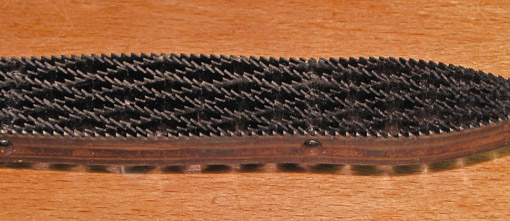
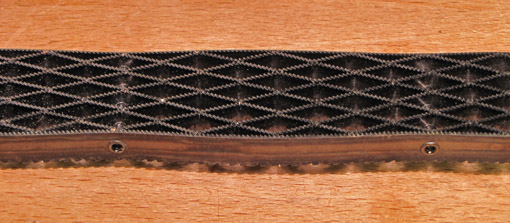
Now let’s look at two brands of machine-made rasps with irregular tooth distribution, a key factor in producing a controlled smooth cut.
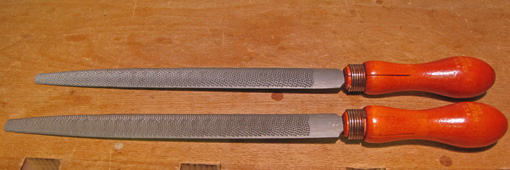
The Nicholson #49, and the slightly finer #50 have been old standbys, and, for a long time, about the only alternative to row-toothed rasps. The current crop, according to what I read, is made in Brazil and the quality has gone down. I still use my old USA-made pair and though they are good rasps, they are not what I reach for first. They are barely 7/8″ wide and teeth do not cover the full width. I prefer a rasp 1 1/4″ wide for general shaping. Though surpassed by better options, especially hand-cut rasps, these still might meet your needs at a low price. I don’t fine much difference in action between the #49 and the #50, so you could do well with just one of them. A close-up of the teeth my #49 and #50 (not the current production), click to enlarge:

Corradi “Gold” rasps are lesser known but excellent tools which are different in character from any others I know of. The machine cut teeth are densely packed in a wavy pattern which effectively presents the teeth randomly to the wood, giving a very controlled steady cut that feels almost like coarse sandpaper on a stick. My 10″ x 1-1/4″ #8 and finer #10 leave the least scratches of any rasps I’ve ever used. Not particularly aggressive, they come into play in the later stages of shaping. They tend to clog relatively quickly but clear easily. The Corradis have earned a solid role in my work but, as a matter of personal preference, do not have the special feel and feedback of the top-quality handcut rasps. A close-up of the teeth of the Corradi #8 and #10, click to enlarge:
Coming up: handcut rasps, handles, some technique, and more.

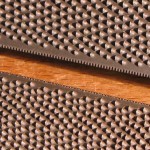
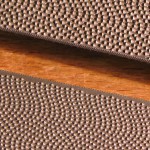

Thanks Rob, great post and informative as always, Rick
I’m glad your doing a bit on rasps! Haven’t had much hands on with them, hard for me to distinguish what is needed vs. what is nice to have.
Hi Rob,
I’m glad to read about the Shinto and Corradi rasps. My older made Nicholson has always been a nice tool for me. Sorry to hear about the quality issue of the new ones.
Tico
Hi Rob, Your review of the Shinto is spot on. I almost always use the medium side and just about every time I think: I wish this was convex. If they come out with a convex version I will happily cough up another $25. Doubtful I will ever wear it out.
All of these tools have different feels on the wood but the Shinto is such a workhorse at a low price and seems to last forever so it’s hard to resist. Tim, maybe Shinto will hear us.
Rob